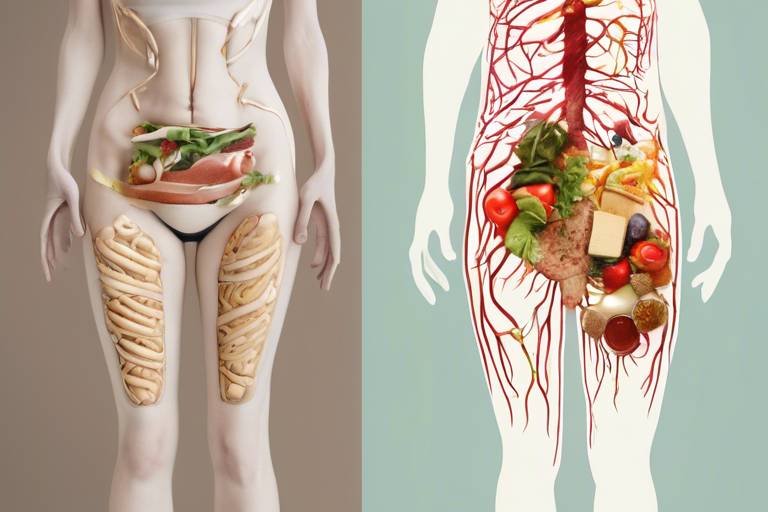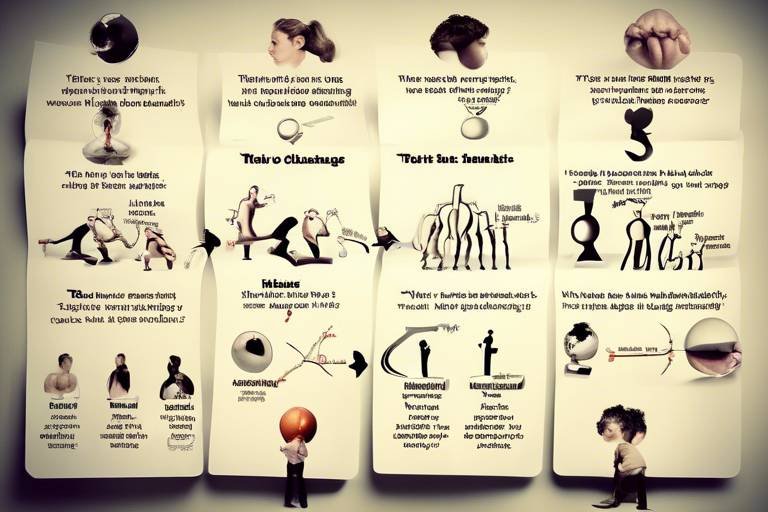The Physics of Home Workouts - Staying Fit Indoors
In today's fast-paced world, finding time to hit the gym can feel like a Herculean task. But what if I told you that you could harness the principles of physics to create an effective workout right in the comfort of your own home? Yes, you heard it right! By understanding the science behind movement and energy, you can transform your living room into a personal fitness studio. Whether you're a fitness newbie or a seasoned pro, the physics of home workouts can help you maximize your efforts and achieve your fitness goals.
Imagine your body as a finely tuned machine, where every movement counts. The way you position yourself, the weights you choose, and even the angles at which you exercise can significantly impact your results. It's like being a conductor of an orchestra, where each part must work in harmony to create a beautiful symphony of fitness. So, let's dive into the fascinating world of physics and see how it can elevate your home workouts!
Resistance training is all about overcoming forces to strengthen your muscles. When you lift weights, you're not just moving them; you're engaging in a battle against gravity. The mechanics of this training involve understanding how different weights and body positions can enhance muscle engagement. For instance, lifting a heavier weight requires more effort, leading to greater muscle growth. But there's more to it than just lifting heavy! The way you position your body can also influence how effectively you work those muscles.
Consider this: when performing a squat, your body acts as a lever. The angle of your hips, knees, and ankles determines how much force you need to generate to lift your body weight. By adjusting your stance or the depth of your squat, you can target different muscle groups and improve your overall strength. It's like fine-tuning an instrument to achieve that perfect sound!
Cardiovascular exercises are essential for burning calories and improving heart health. But have you ever thought about the physics behind energy expenditure during your cardio workouts? When you engage in activities like running or jumping jacks, your body requires energy to perform these movements. This energy comes from the food you consume, and the more intense your workout, the more calories you burn.
To optimize your cardio routines, consider incorporating intervals. By alternating between high-intensity bursts and lower-intensity recovery periods, you can increase your overall energy expenditure. It's like riding a roller coaster; the ups and downs create an exhilarating experience that keeps your body guessing and your metabolism revved up!
Examining body mechanics reveals the importance of posture and movement efficiency in enhancing workout performance. Proper alignment during exercises not only prevents injuries but also maximizes effectiveness. Think of your body as a well-oiled machine; if one part is out of alignment, the whole mechanism can falter. Simple adjustments, like keeping your back straight during deadlifts or engaging your core during planks, can make a world of difference in your workout results.
Gravity is a powerful force that impacts all physical activities. When you’re doing push-ups or squats, gravity is working against you, providing resistance that strengthens your muscles. By understanding how to use gravitational forces to your advantage, you can enhance your strength and stability. For example, elevating your feet during push-ups increases the gravitational load on your upper body, intensifying the workout. It's like adding weights to a seesaw—more weight means more effort!
Did you know that the angle at which you perform an exercise can significantly impact your muscle activation? By adjusting your body position, you can target specific muscles more effectively. For instance, when doing bench presses, changing the angle of the bench can shift the focus from your chest to your shoulders. This concept is akin to adjusting the sails on a boat; the right angle can guide you towards your destination faster!
Balance and stability are key components of fitness that shouldn't be overlooked. Exercises that improve core strength and coordination can enhance your overall performance. Think of your core as the foundation of a house; without a solid base, everything else is at risk. Incorporating stability exercises, like single-leg stands or stability ball workouts, can help you develop a strong core that supports all your physical activities.
Using various equipment can alter workout dynamics significantly. From dumbbells to resistance bands, the tools you choose can affect exercise intensity and effectiveness. For instance, resistance bands provide variable resistance, allowing for a unique workout experience that can be adjusted to your fitness level.
Selecting appropriate equipment is crucial for maximizing results. Consider your fitness goals and the space available in your home. If you're looking to build strength, dumbbells or kettlebells might be your best bet. For cardio, a jump rope or a stationary bike can be fantastic options. It's like choosing the right ingredients for a recipe; the right tools can make all the difference!
Creating your own workout equipment can be both cost-effective and fun. For example, you can fill a backpack with books for added weight during squats or use a sturdy chair for step-ups. These innovative DIY solutions can enhance your home workout experience without breaking the bank. Plus, it’s a great way to get creative and make fitness a personal journey!
- Can I really get fit working out at home? Absolutely! With the right techniques and understanding of physics, you can achieve amazing results from home workouts.
- What equipment do I need for effective home workouts? You can start with basic equipment like dumbbells, resistance bands, or even household items for a variety of exercises.
- How can I ensure proper form during exercises? Consider watching instructional videos or consulting with a fitness professional to learn the correct techniques and body mechanics.
- Is it important to vary my workouts? Yes! Varying your workouts helps prevent plateaus and keeps your routine exciting and effective.

The Science of Resistance Training
Understanding the mechanics of resistance training is like unlocking the secrets to a treasure chest of fitness gains. It’s not just about lifting weights; it’s about how you lift them, the angles you use, and even the way you position your body. When you engage in resistance training, you're not merely pushing against an object; you're manipulating forces to maximize muscle engagement and growth. Think of your muscles as rubber bands. The more you stretch and contract them against resistance, the stronger they become.
So, what exactly influences the effectiveness of your workout? Several factors come into play, including the type of resistance, your body position, and the movement patterns you employ. Let's break it down:
| Factor | Description |
|---|---|
| Type of Resistance | Free weights, machines, bands, and bodyweight exercises each offer unique benefits and challenges. |
| Body Positioning | Your posture can either enhance or hinder your ability to lift effectively. Proper alignment is crucial. |
| Movement Patterns | Understanding how to perform exercises correctly can prevent injuries and ensure maximum muscle engagement. |
When it comes to resistance training, the principle of progressive overload is vital. This means gradually increasing the weight, frequency, or number of repetitions in your workouts. Imagine trying to fill a balloon with air. If you only blow a little, it won’t expand much. But if you keep adding air, it eventually bursts! In fitness, consistently challenging your muscles leads to growth and strength gains.
Another important aspect is the time under tension. This refers to how long your muscles are under strain during an exercise. For instance, if you’re doing a bicep curl, the longer you keep the weight lifted, the more your muscles have to work. This can lead to greater muscle hypertrophy. So, next time you’re working out, try slowing down your movements. Instead of rushing through your reps, savor the tension and feel the burn!
Lastly, let’s touch on the concept of muscle engagement. Not all exercises target the same muscles in the same way. For example, squats primarily work the quadriceps, hamstrings, and glutes, while deadlifts also engage your back and core. Understanding which muscles are activated during different exercises can help you tailor your workouts for balanced strength development. To illustrate this, consider the following:
- Squats: Primarily target the lower body.
- Bench Press: Focuses on the chest, shoulders, and triceps.
- Deadlifts: Engage the entire posterior chain, including the back and legs.
In conclusion, mastering the science of resistance training is essential for anyone looking to enhance their fitness routine. By understanding the mechanics behind your movements, you can make informed decisions that lead to better results. Whether you’re a beginner or a seasoned athlete, applying these principles will undoubtedly elevate your home workouts to new heights.

When it comes to fitness, cardiovascular exercises are often hailed as the champions of calorie burning. But have you ever wondered why that is? The secret lies in the science of energy expenditure. Essentially, energy expenditure refers to the number of calories your body uses during physical activities, and understanding this concept can significantly enhance your home workout routine.
During a cardio workout, your body engages in various processes that require energy. This energy primarily comes from the calories you consume through food. The more intense your workout, the more energy your body demands. For instance, running or cycling at a high intensity will burn more calories than a leisurely walk. This is where the physics of movement comes into play. The faster you move, the more energy your muscles require, leading to a higher rate of calorie burning.
To truly optimize your cardio workouts, consider incorporating different types of exercises that challenge your body in unique ways. Here are some effective cardio options:
- High-Intensity Interval Training (HIIT): This involves short bursts of intense activity followed by rest or low-intensity periods, maximizing calorie burn in a shorter time.
- Steady-State Cardio: This includes activities like jogging or cycling at a consistent pace, which can be great for endurance building.
- Circuit Training: Combining strength exercises with cardio elements keeps your heart rate elevated and enhances energy expenditure.
Now, let's break down how we can measure energy expenditure during these workouts. One common method is by calculating your Metabolic Equivalent of Task (MET). MET is a unit that estimates the amount of oxygen used by the body during physical activity compared to resting. For example, a MET value of 8 indicates that you're burning eight times the calories than you would while sitting still. Here’s a quick reference table for some popular cardio activities:
| Activity | MET Value | Calories Burned (per hour for a 155 lb person) |
|---|---|---|
| Running (6 mph) | 10 | 660 |
| Cycling (12-14 mph) | 8 | 540 |
| Jump Rope | 12 | 780 |
| Walking (4 mph) | 4.3 | 280 |
As you can see, the type of cardio you choose can greatly influence your total calorie burn. But don’t forget about the duration and frequency of your workouts. Generally, the longer and more frequently you engage in cardio, the more calories you will burn. Aim for at least 150 minutes of moderate-intensity or 75 minutes of vigorous-intensity cardio each week, as recommended by health experts.
Another important factor to consider is post-exercise oxygen consumption (EPOC), also known as the "afterburn effect." This phenomenon occurs when your body continues to burn calories even after you’ve finished your workout, as it works to restore itself to a resting state. Engaging in high-intensity workouts can significantly increase EPOC, leading to greater energy expenditure throughout the day.
In conclusion, understanding the physics behind energy expenditure during cardio workouts can empower you to make informed choices about your fitness routine. By incorporating a variety of exercises, measuring your MET, and being mindful of workout duration and intensity, you can maximize your calorie burn and achieve your fitness goals—all from the comfort of your own home.
Q: How often should I do cardio for optimal results?
A: Aim for at least 150 minutes of moderate-intensity or 75 minutes of vigorous-intensity cardio each week, spread out over several days.
Q: Can I do cardio every day?
A: Yes, you can do cardio every day, but it's essential to listen to your body. Incorporate rest days or low-intensity workouts to prevent injury.
Q: Is HIIT better than steady-state cardio?
A: Both have their benefits! HIIT can lead to greater calorie burn in a shorter time, while steady-state cardio is excellent for building endurance. Choose what fits your goals and preferences.

When it comes to working out, understanding body mechanics is like having a secret weapon in your fitness arsenal. Think of it as the blueprint for how your body moves and functions during exercise. Just like a well-oiled machine, your body needs to be in perfect alignment to perform at its best. Have you ever noticed how some exercises feel easier for some people than others? That’s often due to their understanding of body mechanics!
At its core, body mechanics involves the way your body moves and the forces that act upon it. This includes everything from your posture to the way you engage your muscles. For instance, when you're doing a squat, proper alignment ensures that your knees don’t buckle inward, which can lead to injury. Instead, by keeping your knees aligned with your toes, you're distributing weight evenly and protecting your joints.
Moreover, movement efficiency is key. Imagine trying to push a heavy box across the floor. If you’re hunched over and using all your back muscles, you’ll tire quickly. But if you engage your legs, keep your back straight, and use your body weight to your advantage, you’ll find it much easier to move that box. The same principle applies to exercises like deadlifts or push-ups. By using the correct form and engaging the right muscles, you can maximize your workout and minimize strain.
Let’s break down some important elements of body mechanics that can enhance your workout:
- Posture: Maintaining a neutral spine is crucial for almost every exercise. This means keeping your head aligned with your spine and avoiding excessive curvature.
- Range of Motion: Utilizing the full range of motion in exercises can lead to greater muscle activation. For example, in a bench press, lowering the bar to your chest before pushing it back up engages more muscle fibers than a partial rep.
- Breathing: Proper breathing techniques can enhance performance. Exhaling during exertion (like pushing or lifting) helps stabilize your core and provides more power.
Understanding these mechanics can help you not only perform exercises correctly but also prevent injuries. It’s essential to listen to your body. If something doesn’t feel right, it’s worth adjusting your form or even taking a break. Remember, fitness is a journey, and your body is your most important tool.
Incorporating these principles into your home workouts can significantly improve your results. Whether you're doing yoga, lifting weights, or engaging in cardio, paying attention to body mechanics will ensure that you're making the most of your time and effort. So, the next time you hit your home gym, think about how you’re moving. Are you aligned correctly? Are you using your body efficiently? Answering these questions can lead to a more productive and enjoyable workout experience!
Q: Why is body mechanics important in exercise?
A: Body mechanics is crucial because it ensures that you perform exercises safely and effectively, reducing the risk of injury while maximizing muscle engagement.
Q: How can I improve my body mechanics?
A: You can improve your body mechanics by focusing on proper posture, using the full range of motion, and practicing correct breathing techniques during your workouts.
Q: What should I do if I feel pain while exercising?
A: If you experience pain, it’s important to stop the exercise immediately and assess your form. If the pain persists, consult a fitness professional or a healthcare provider.

When we think about working out at home, we often focus on the exercises themselves, but have you ever stopped to consider the power of gravity? Gravity is not just a background force; it’s a vital component that can significantly enhance your workout effectiveness. Every time you lift a weight or perform a push-up, gravity is working against you, and understanding this can transform your approach to fitness.
First off, let’s talk about how gravity influences resistance training. When you lift weights, you're not just moving them; you're working against the gravitational pull that tries to bring them back down. This means that the heavier the weight, the more effort you need to exert to lift it. But here's the kicker: by adjusting the angle of your body during exercises, you can manipulate the effects of gravity to target different muscle groups more effectively. For instance, performing a bench press at an incline engages your upper chest more than a flat bench press, all thanks to the angle at which gravity acts on the weights.
Moreover, gravity affects your body’s alignment and stability during workouts. When you're standing upright, your center of gravity is higher, making you more susceptible to losing balance. This is why exercises like squats and deadlifts require proper form; a misalignment can lead to injury. To maintain stability, it's crucial to keep your weight distributed evenly and your core engaged. Think of your core as the anchor that keeps you grounded while gravity tries to pull you off balance.
Here’s a fun fact: the force of gravity is not the same everywhere. For example, if you were to do your workouts at a higher altitude, the gravitational pull would be slightly less than at sea level. While this difference is minimal, it can still have an impact on your performance and endurance. So, if you're living in the mountains and feel like your workouts are getting easier, it might just be the altitude playing tricks on you!
To take advantage of gravity in your home workouts, consider incorporating exercises that utilize your body weight. Movements like pull-ups and push-ups are fantastic examples. In these exercises, gravity is your primary resistance, and by varying your body position, you can increase or decrease the difficulty. For example, elevating your feet during push-ups increases the gravitational load on your upper body, making the exercise more challenging.
In summary, gravity is not just a force; it’s your workout partner. By understanding how to leverage it effectively, you can enhance your strength training, improve your stability, and ultimately achieve better results from your home workouts. So, the next time you're sweating it out in your living room, remember to give a nod to gravity for being the unsung hero of your fitness journey.
- How does gravity affect my workout? Gravity provides the resistance needed for strength training and impacts your balance and stability during exercises.
- Can I manipulate gravity to enhance my workouts? Yes! By adjusting your body angle and using bodyweight exercises, you can effectively change how gravity works in your favor.
- Does the force of gravity change based on location? Yes, gravity is slightly weaker at higher altitudes, which can affect your workout intensity.

When it comes to maximizing your home workouts, angles matter more than you might think. Just like a skilled archer knows that the angle of the arrow can determine whether it hits the target, understanding how to manipulate angles in your exercises can significantly enhance your performance and results. So, how can you leverage angles to get the most out of your workouts? Let’s dive into it!
First off, consider the basic principle of mechanical advantage. This is the concept that by changing the angle at which you perform an exercise, you can alter the amount of force required to complete it. For instance, when doing a push-up, changing your hand placement or the angle of your body can target different muscle groups. A wider hand placement shifts more focus onto your chest, while a narrower stance engages your triceps more effectively.
Moreover, think about the impact of gravity on your exercises. Different angles can either increase or decrease the gravitational pull on your body, influencing how hard your muscles need to work. For example, performing a squat with your back against a wall (a wall sit) creates a scenario where your legs are under constant tension due to the angle of your body relative to the ground. This not only builds strength but also improves endurance.
Let’s take a look at some common exercises and how adjusting angles can optimize them:
| Exercise | Angle Change | Effect |
|---|---|---|
| Push-Up | Feet Elevated | Increased chest activation |
| Squat | Wide Stance | Targets inner thighs |
| Deadlift | Sumo Position | Engages glutes and hamstrings more |
| Plank | Forearm vs. Hands | Shifts focus on core stability |
In addition to strength training, angles also play a vital role in cardio workouts. For example, when cycling, adjusting the seat height and angle can make a tremendous difference in your efficiency and comfort. A proper angle helps to engage the right muscle groups, preventing strain and enhancing your overall performance.
So, how can you apply this knowledge in your home workouts? Start by experimenting with different angles during your exercises. Try elevating your feet during push-ups or adjusting the incline on your treadmill. Pay attention to how these changes affect your body and your workout intensity. Remember, the goal is to challenge your muscles in new ways, and angles are a powerful tool in achieving that!
In conclusion, leveraging angles in your workouts is not just about making things more challenging; it’s about smart training. By understanding how to manipulate angles, you can enhance muscle activation, improve your form, and ultimately, achieve better results. So, the next time you hit the mat or the weights, think about the angles and how they can work for you!
- How do I know what angle to use for my exercises? Experiment with different angles and observe how they affect your performance and muscle engagement.
- Can changing angles prevent injuries? Yes, using the correct angles can help maintain proper form, reducing the risk of injuries.
- Are there any exercises where angles don't matter? Most exercises can benefit from angle adjustments, but some may have less impact than others.

When it comes to home workouts, balance and stability often take a backseat to more glamorous exercises like squats and push-ups. However, these elements are crucial for a well-rounded fitness routine. Imagine trying to build a house on a shaky foundation; it simply won’t stand the test of time. Similarly, without a solid core and stable movements, your fitness gains can be compromised. So, how can you incorporate balance and stability training into your routine?
First off, let's talk about the core. Your core isn't just your abs; it includes all the muscles that support your spine and pelvis. A strong core enhances your overall stability, making it easier to perform various exercises safely and effectively. Think of your core as the trunk of a tree; if it's strong, the branches (your limbs) can reach out without the risk of toppling over. Incorporating exercises like planks, bird dogs, and stability ball workouts can significantly improve your core strength.
Another essential aspect of balance and stability training is proprioception, which is your body's ability to sense its position in space. This is where exercises like single-leg stands and balance board routines come into play. These movements challenge your body to maintain equilibrium, engaging various muscle groups and improving coordination. You can even use everyday items around your home, like a sturdy chair or a pillow, to create your own balance challenges.
To illustrate the impact of balance training, consider the following table:
| Exercise | Muscle Groups Engaged | Benefits |
|---|---|---|
| Single-leg Deadlift | Hamstrings, Glutes, Core | Improves balance and strengthens posterior chain |
| Plank with Arm Lift | Core, Shoulders | Enhances core stability and shoulder strength |
| Balance Board Squats | Legs, Core | Increases leg strength and balance |
Incorporating these exercises into your routine doesn’t have to be complicated. You can start with just a few minutes each day, gradually increasing your time as you become more comfortable. Remember, consistency is key! Just like building any skill, practice makes perfect. You might even find that as you improve your balance, other exercises become easier and more effective.
So, why not challenge yourself? Set a goal to include balance and stability training in your home workouts at least two to three times a week. You’ll not only notice improvements in your physical capabilities but also in your overall confidence and body awareness. After all, who wouldn’t want to feel like a superhero, effortlessly gliding through workouts with grace and poise?
- How often should I do balance training? Aim for at least 2-3 times a week to see significant improvements.
- Can I do balance exercises without equipment? Absolutely! Many balance exercises can be done using just your body weight.
- What are some beginner-friendly balance exercises? Start with single-leg stands, heel-to-toe walks, and simple yoga poses like Tree Pose.

When it comes to home workouts, the equipment you choose can significantly influence your fitness journey. Whether you’re a seasoned athlete or just starting out, understanding how different tools can enhance your routine is essential. The right equipment not only makes your workouts more effective but can also keep you motivated and engaged. So, what should you consider when selecting workout tools? Let’s dive into the world of fitness equipment and discover how it can transform your home exercise experience!
First off, let’s talk about the various types of equipment available. From dumbbells and kettlebells to resistance bands and yoga mats, each piece serves a unique purpose. For example, dumbbells are fantastic for building strength, while resistance bands offer versatility and can be used for a wide range of exercises. But it’s not just about having a variety of tools; it’s about understanding how to use them effectively. Using the wrong equipment or performing exercises incorrectly can lead to injuries or suboptimal results.
To make the most out of your workouts, consider the following factors when choosing your equipment:
- Fitness Goals: Are you looking to build strength, improve flexibility, or enhance cardiovascular health? Your goals will dictate the type of equipment you should invest in.
- Space Availability: Do you have a dedicated workout area? If space is limited, opt for compact equipment that can be easily stored.
- Budget: You don’t need to break the bank to get fit. There are plenty of affordable options that can deliver great results.
Now, let’s explore how different equipment can impact your workouts. For strength training, using free weights allows for a greater range of motion and engages more stabilizing muscles compared to machines. This can lead to better overall muscle development. On the other hand, machines can provide guided support, making them ideal for beginners who may not be familiar with proper form.
When it comes to cardio, equipment like jump ropes or stationary bikes can elevate your heart rate and increase calorie burn. A simple jump rope can be a game-changer for those looking to improve their cardiovascular fitness without requiring much space or investment. In fact, studies have shown that just 10 minutes of jump rope can provide the same cardiovascular benefits as 30 minutes of jogging!
Let’s not forget about the importance of bodyweight exercises. Sometimes, the best equipment is your own body. Exercises like push-ups, squats, and planks can be incredibly effective and require no equipment at all. However, adding tools like resistance bands can amplify these moves, providing extra tension that helps build strength and endurance.
In conclusion, the impact of equipment on workouts cannot be overstated. It’s about finding the right balance between what you have, what you need, and how you can use it to achieve your goals. Remember, the most important thing is to stay consistent and keep challenging yourself, regardless of the equipment at hand. Now that you’re equipped with this knowledge, it’s time to hit that home gym and make the most out of your workouts!
Q: Do I need a lot of equipment to get fit at home?
A: Not at all! You can achieve great results with minimal equipment. Focus on bodyweight exercises and a few versatile tools like dumbbells or resistance bands.
Q: How can I create a workout space in a small area?
A: Consider using foldable or multi-functional equipment that can be easily stored. Clear a small area in your living room or bedroom and keep it organized for easy access.
Q: What’s the best equipment for beginners?
A: Start with basic items like resistance bands, a yoga mat, and a pair of light dumbbells. These tools will help you build a solid foundation without overwhelming you.

When it comes to home workouts, selecting the right equipment can make all the difference in your fitness journey. With so many options available, it can feel overwhelming. But fear not! Understanding your fitness goals and the types of exercises you enjoy can help guide your choices. Think of it like picking the right tools for a DIY project; the right equipment not only makes the job easier but also more enjoyable.
First and foremost, consider what you want to achieve. Are you looking to build strength, improve your cardiovascular health, or perhaps enhance your flexibility? Each goal requires a different set of tools. For instance, if strength training is your focus, you might want to invest in dumbbells, kettlebells, or resistance bands. On the other hand, if you're leaning towards cardio, items like a jump rope or a stationary bike could be more beneficial.
Next, think about your available space. Not everyone has a dedicated home gym, and that's perfectly okay! Many effective workout tools are compact and can be easily stored away. Resistance bands, for example, are incredibly versatile and take up very little room, yet they can provide a challenging workout. Similarly, a yoga mat is essential for floor exercises and stretches, making it a must-have in any home gym setup.
Another important factor is your budget. Quality equipment doesn’t have to break the bank. There are plenty of affordable options that can still deliver excellent results. In fact, some of the best workouts can be done with minimal equipment. Bodyweight exercises, such as push-ups and squats, require nothing but your own weight, proving that you don’t need fancy gear to get fit.
Here’s a quick breakdown of some popular equipment options and their benefits:
| Equipment | Benefits |
|---|---|
| Dumbbells | Great for strength training, versatile for various exercises. |
| Resistance Bands | Portable, effective for strength and flexibility, suitable for all fitness levels. |
| Jump Rope | Excellent for cardio, improves coordination and agility. |
| Yoga Mat | Essential for floor exercises, provides comfort and stability. |
Lastly, don’t forget to consider your personal preferences. If you enjoy using certain equipment, you’re more likely to stick with your workouts. Think about what excites you! Maybe you love the feeling of lifting weights or perhaps you find joy in dancing while using a fitness ball. Engagement is key to consistency, so choose equipment that you look forward to using.
In conclusion, choosing the right equipment for home workouts is about finding what aligns with your goals, fits your space, and matches your budget while also keeping you motivated and engaged. Remember, fitness is a personal journey, and the best equipment is the one that helps you stay active and healthy in a way that feels right for you.
- What equipment do I need for a full-body workout?
For a full-body workout, consider having dumbbells, resistance bands, and a yoga mat. These tools allow you to target all major muscle groups effectively. - Can I get fit without any equipment?
Absolutely! Bodyweight exercises like push-ups, squats, lunges, and planks can provide a challenging workout without any equipment. - How do I choose the right weight for dumbbells?
Start with a weight that allows you to perform 8-12 repetitions with good form. If you can easily do more than 12 reps, it might be time to increase the weight.

When it comes to home workouts, creativity can be just as important as the exercises themselves. You don’t need to spend a fortune on fancy gym equipment to get fit; in fact, many effective solutions can be crafted right from the comfort of your home. Think of your living space as a fitness playground! With a little ingenuity, you can transform everyday items into workout tools that will keep you engaged and challenged.
For instance, did you know that a simple backpack filled with books can serve as a makeshift weight? By adjusting the load, you can modify the intensity of your exercises. This is especially useful for exercises like squats or lunges, where you can add resistance to enhance muscle engagement. Just remember to secure the zippers to prevent any sudden surprises during your workout!
Another great DIY solution is using water bottles as dumbbells. Fill them with water or sand to achieve the desired weight. Not only are they easy to grip, but they also allow you to perform a variety of exercises, from bicep curls to shoulder presses. Plus, they’re readily available and can be adjusted according to your strength levels!
If you're looking to improve your core strength, consider creating a stability ball using a large, inflated beach ball. Simply sit on it while performing exercises like crunches or planks to engage your core muscles more effectively. Just be cautious and ensure the ball is properly inflated to avoid any unexpected bounces!
For those who enjoy resistance training, you can easily make resistance bands using old bicycle inner tubes. These provide a fantastic way to add resistance to your workouts without taking up much space. Simply cut the inner tube to your desired length and use it for exercises like lateral raises or leg extensions. It’s a sustainable way to repurpose materials while getting a great workout!
Let’s not forget about plyometric boxes. You can create your own by stacking sturdy items like books or crates. These can be used for box jumps, step-ups, and various other exercises that build power and agility. Just make sure whatever you stack is stable and can support your weight safely!
In summary, the world of DIY fitness equipment is vast and filled with possibilities. By utilizing common household items, you can enhance your workout experience without breaking the bank. So, get creative, and remember that the only limit is your imagination!
Q: Are DIY equipment solutions safe to use?
A: Yes, as long as you ensure that the items are stable and can support your weight. Always test them before incorporating them into your workout.
Q: Can I really get a good workout using DIY equipment?
A: Absolutely! Many bodyweight exercises and DIY solutions can provide a challenging workout that targets multiple muscle groups.
Q: What if I don’t have any equipment at home?
A: No worries! Bodyweight exercises like push-ups, squats, and lunges can be highly effective and require no equipment at all.
Q: How do I know what weight to use for my DIY equipment?
A: Start with lighter weights and gradually increase the load as you become more comfortable with the exercises. Listen to your body to avoid injuries.
Frequently Asked Questions
- What is resistance training and how does it work?
Resistance training involves exercises that improve strength and endurance by working against an external force. This can be achieved using weights, resistance bands, or even your own body weight. The key is to create tension in your muscles, which stimulates growth and increases muscle engagement. By understanding how to position your body and the weights you are using, you can maximize the effectiveness of your workouts.
- How can I optimize my cardio workouts for better results?
To get the most out of your cardio sessions, focus on maintaining a steady pace that keeps your heart rate elevated. Incorporating interval training, where you alternate between high and low-intensity bursts, can also help burn more calories. Additionally, understanding the physics of energy expenditure can guide you in choosing exercises that maximize calorie burn, such as jumping jacks or burpees, which engage multiple muscle groups.
- Why is body mechanics important in exercise?
Body mechanics refers to the way we move and the alignment of our bodies during exercise. Proper body mechanics can enhance performance and reduce the risk of injury. For instance, maintaining a straight back while lifting weights ensures that the load is distributed evenly, preventing strain on your back. Learning about body mechanics can help you perform exercises more efficiently and effectively.
- How does gravity affect my workouts?
Gravity is a constant force that affects all physical activities. When you perform exercises, like squats or push-ups, gravity helps create resistance, making your muscles work harder. By understanding how to leverage gravity—such as adjusting your body position or angle—you can improve strength and stability during your home workouts.
- What role do angles play in exercise effectiveness?
Angles can significantly impact muscle activation and overall workout effectiveness. For example, changing the angle of your push-up can target different muscle groups, such as the chest or shoulders. Experimenting with various angles not only enhances muscle engagement but also helps reduce the risk of injury by promoting better form.
- What exercises can improve balance and stability?
Exercises like planks, single-leg stands, and stability ball workouts can greatly enhance your core strength and coordination. These movements challenge your balance and engage stabilizing muscles, which are crucial for overall fitness. Incorporating balance and stability training into your routine can lead to improved performance in other exercises and everyday activities.
- How does equipment impact my workouts?
The type of equipment you use can alter the dynamics of your workout. For instance, dumbbells allow for a greater range of motion compared to resistance bands, which can provide constant tension throughout the movement. Understanding how different tools affect intensity and effectiveness can help you tailor your workouts to meet your fitness goals.
- How do I choose the right equipment for my home workouts?
Choosing the right equipment depends on your fitness goals, available space, and budget. If you're looking to build muscle, consider investing in dumbbells or resistance bands. For cardio, items like jump ropes or kettlebells can be effective. Always remember to select equipment that you feel comfortable using and that aligns with your workout preferences.
- Can I create my own workout equipment?
Absolutely! DIY equipment solutions can be both cost-effective and fun. For example, you can use filled water bottles as weights or a sturdy chair for step-ups. Creativity in your home workout setup can enhance your experience without breaking the bank, allowing you to stay fit with what you have on hand.



















